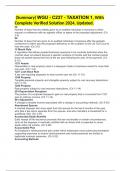Summary
(Summary) WGU - C237 - TAXATION 1, With Complete Verified Solution 2024, Updated.
- Module
- Institution
(Summary) WGU - C237 - TAXATION 1, With Complete Verified Solution 2024, Updated. 30 Number of days that are initially given to an audited individual or business to either request a conference with an appeals officer or agree to the proposed adjustment. (Ch 2-6) 90 Number of days that are given...
[Show more]



